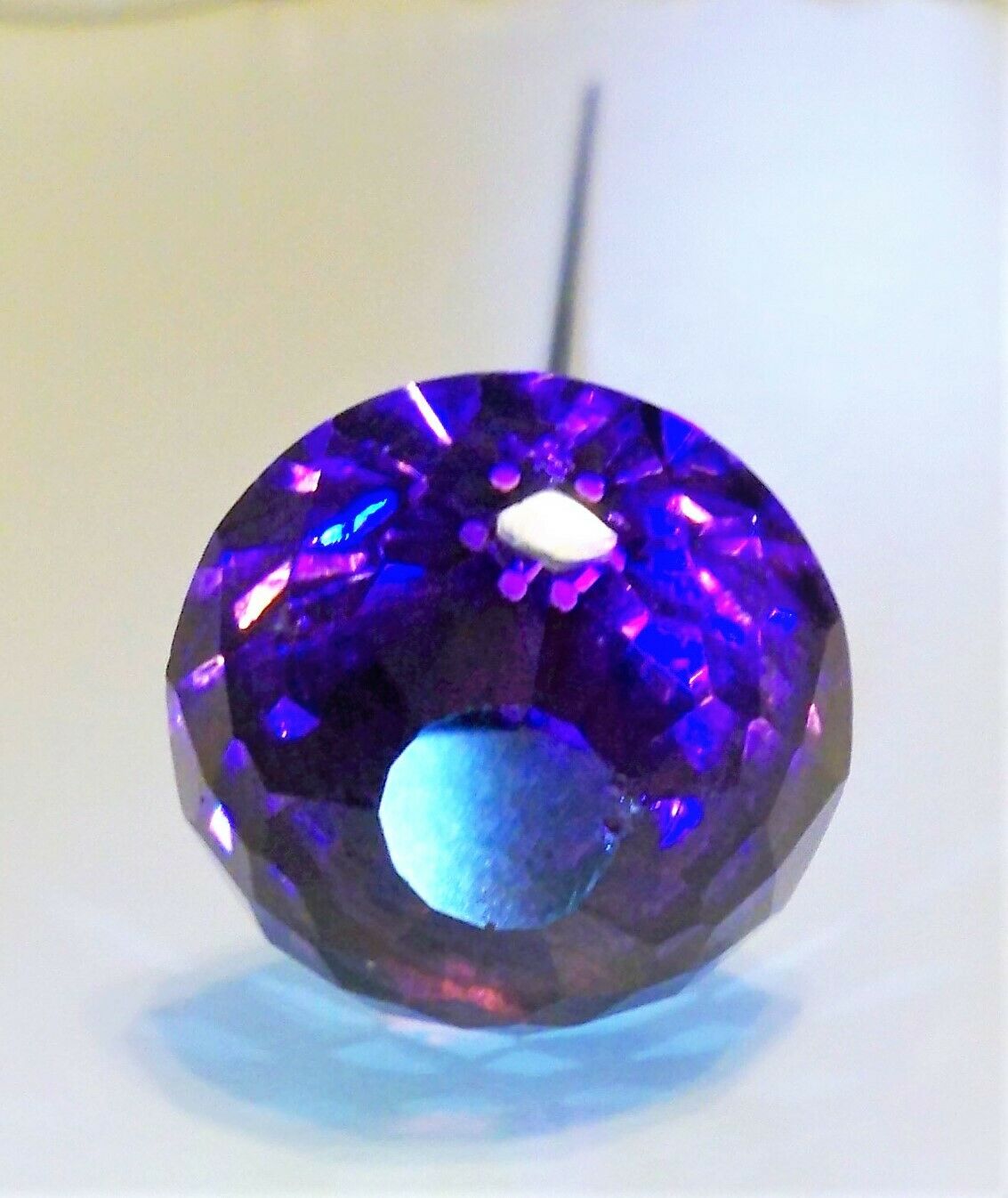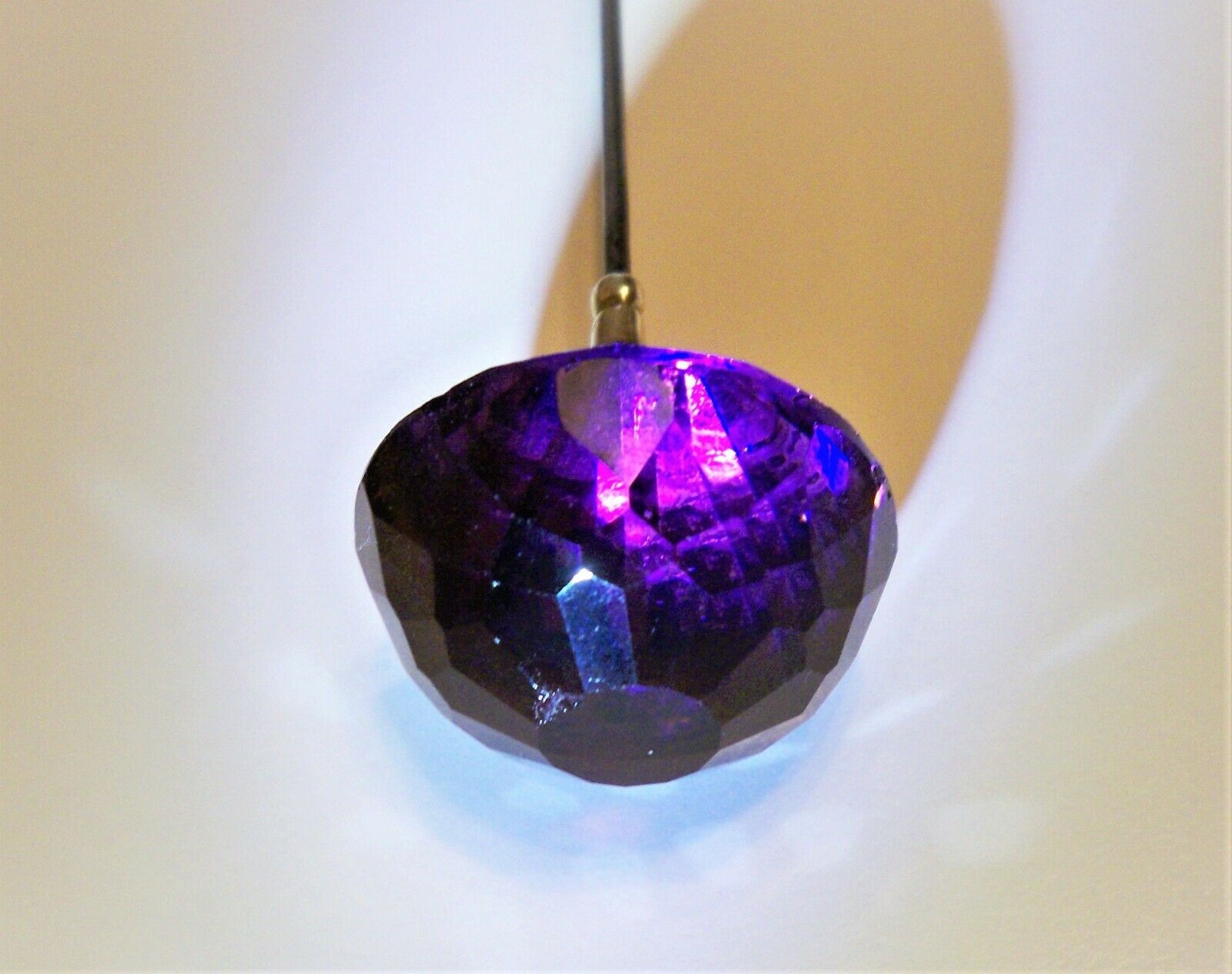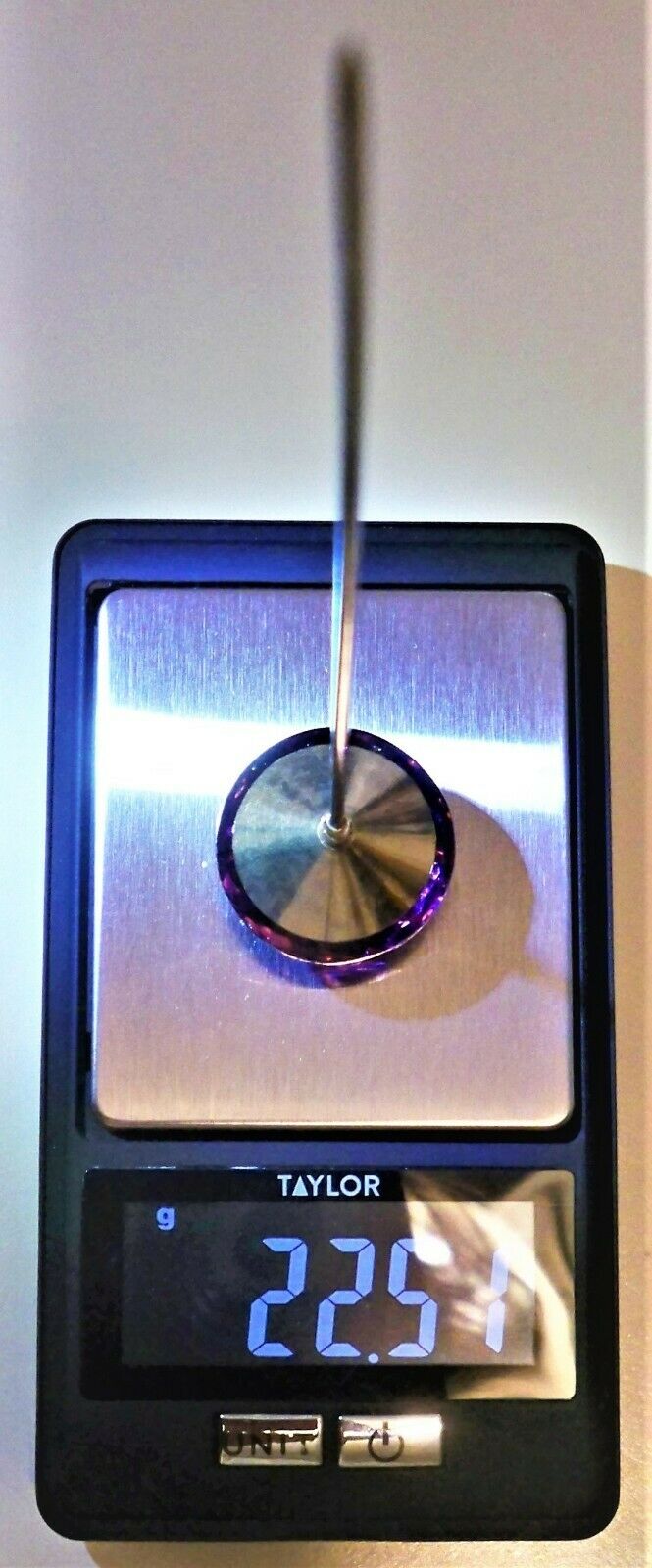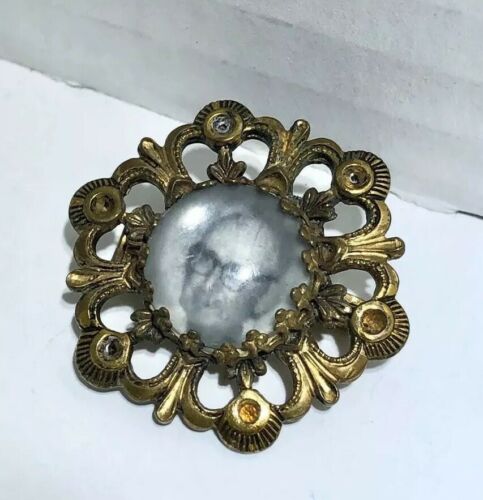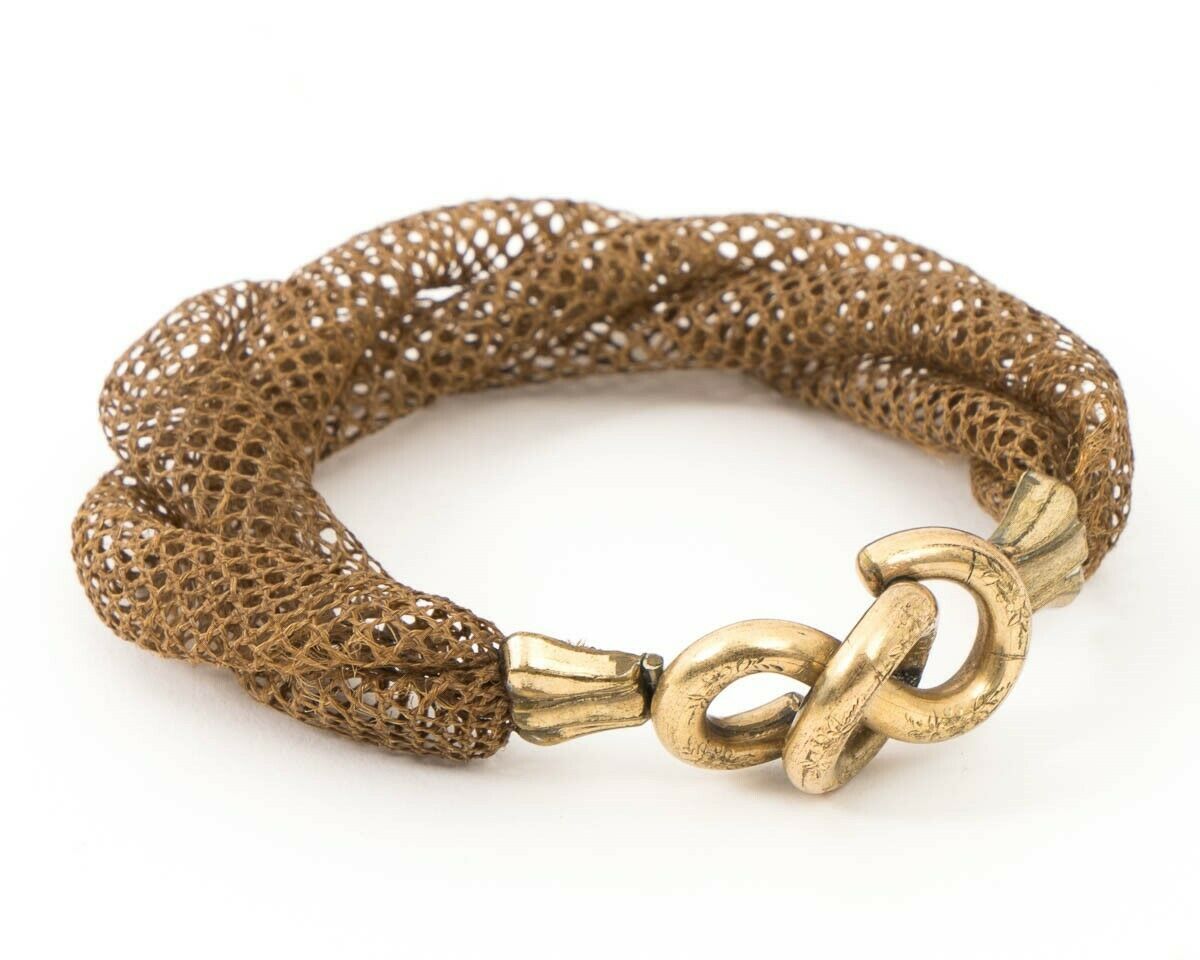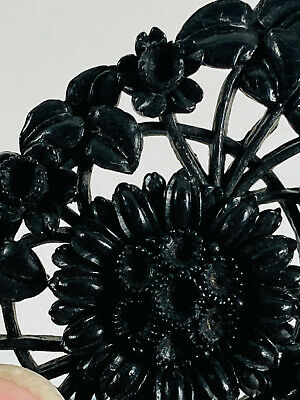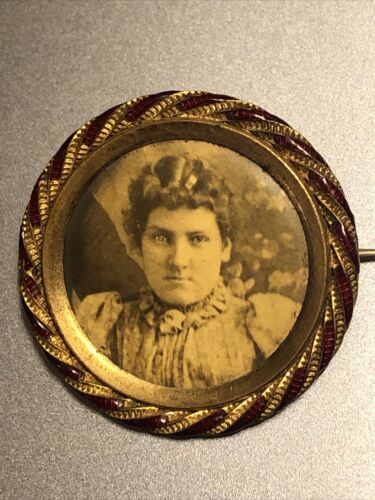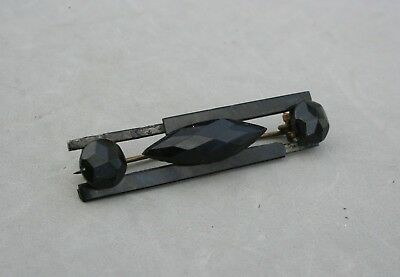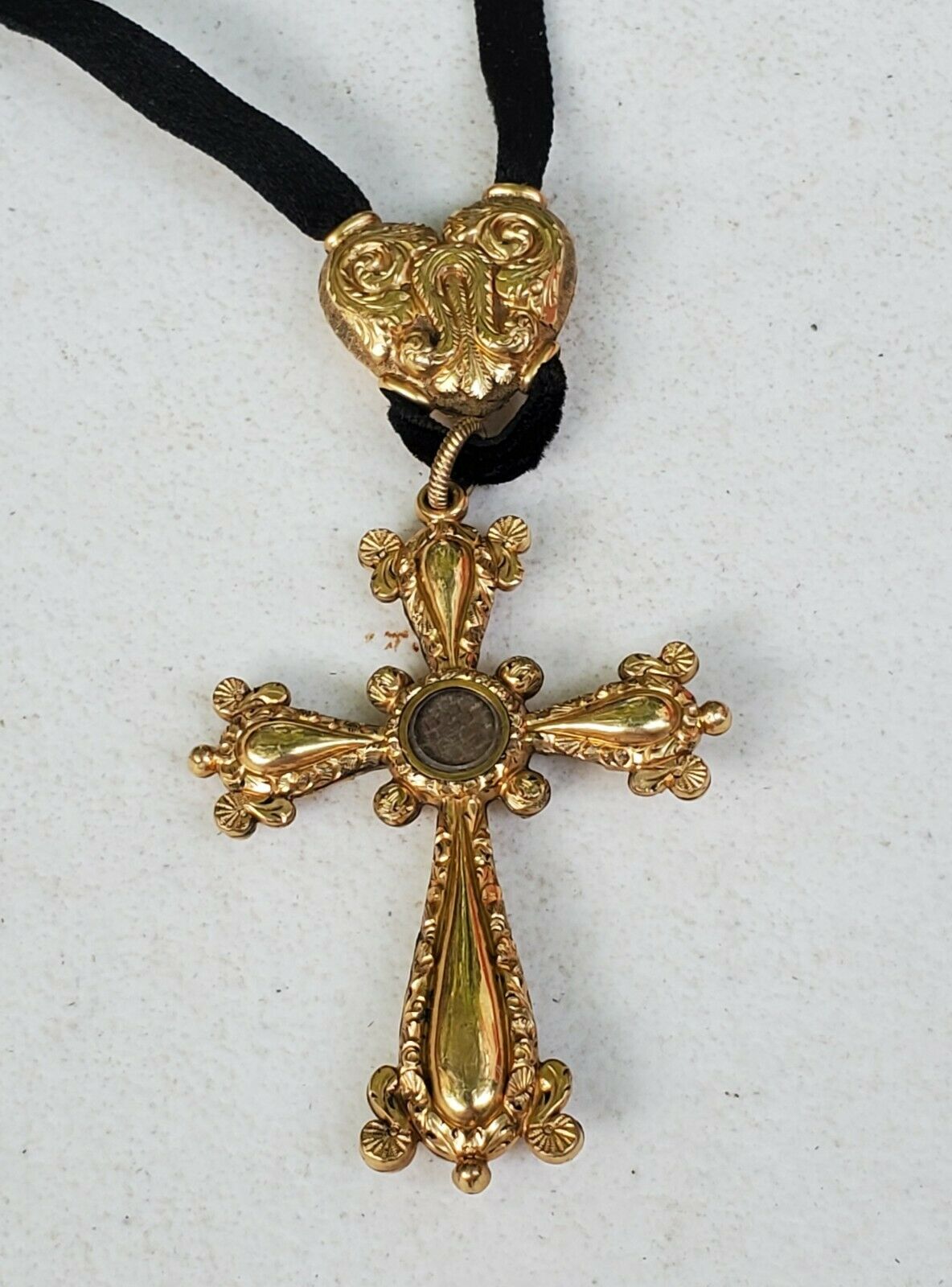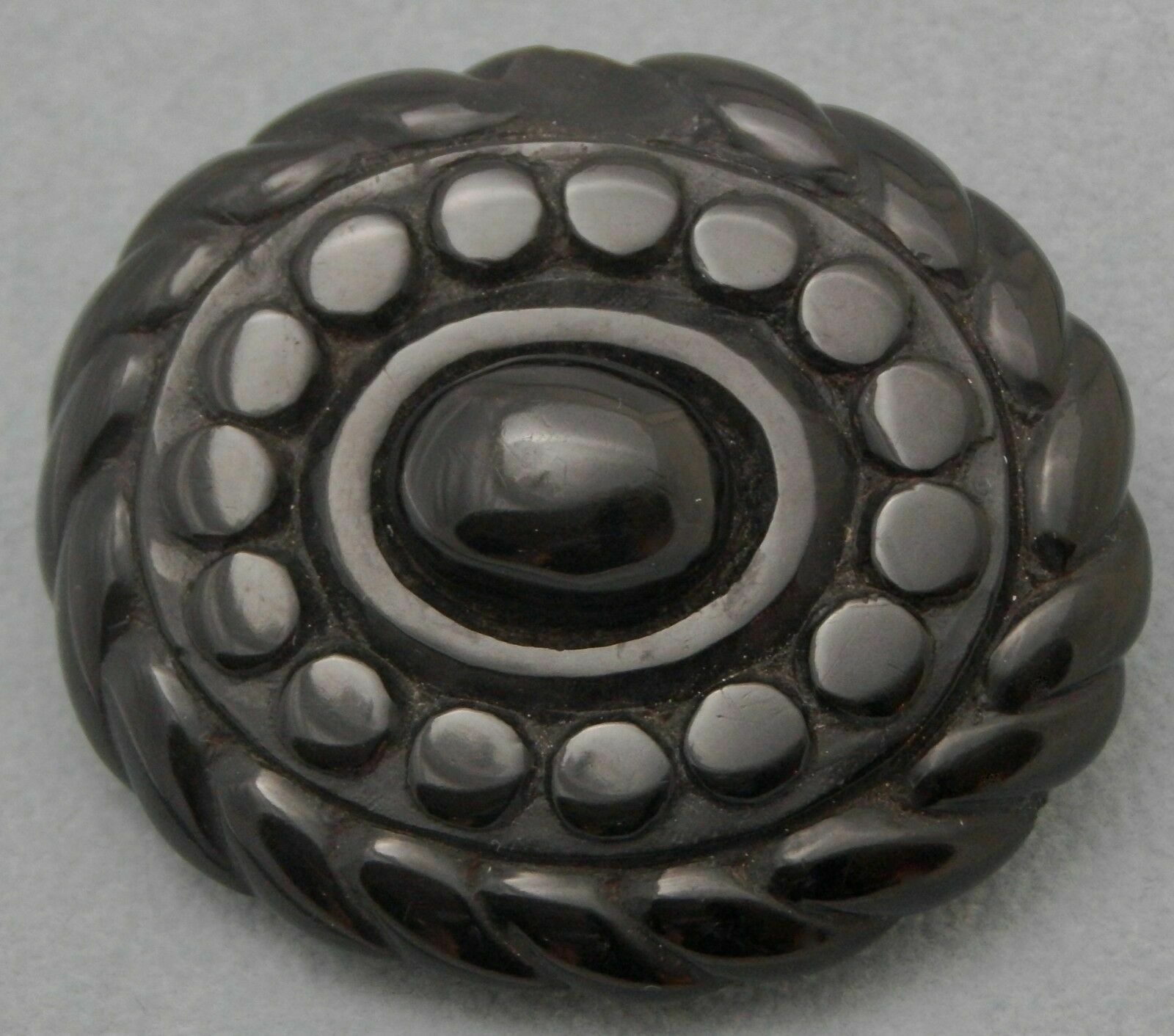-40%
Pristine Antique (95-130 yrs.) Victorian Era Brass & Amethyst Glass Long Hatpin
$ 39.6
- Description
- Size Guide
Description
ICONICHIG
H
END
VINTAGE
&
ANTIQUE
COLLECTIBLES
ITEM
:
Pristine Antique (95-130 Years Old) Victorian Era Brass & Amethyst Glass Long Hat Pin
I'm no expert on long hatpins; I just happen to own a couple. For the same reason, I've copied a comprehensive, but very readable explanation entitled, "What All These Hatpins Were For, and Why We Stopped Using Them" (by Maribeth Keane, Collectors Weekly Staff), under RESEARCH immediately below.
As for this pin, it is a striking antique in wonderful condition. It is exceptionally clean and straight (I did have to clean it using Simichrome Paste
; the pin was at risk of becoming corroded). The Amethyest Glass crown is extraordinary, with minor surface wear
commensurate with age
, and nestled in a beautiful brass setting. It is 1 inch in diameter and 3/4 inch from the top edge of the brass setting to the peak.
The pin is 7 inches long. The piece weighs in at exactly 22.51 grams. Please consider the illustrations.
Note; Collectors don't need an additional reason to collect. I know because I am one. Investors, however, do.
In its Current State, this pin offers not only aesthetic excellence but a significant investment opportunity. That is the beauty of quality craftsmanship and iconic design: it looks better, lasts longer, and continues to appreciate in value.
JEM
RESEARCH
What All These Hatpins Were For, and Why We Stopped Using Them
By Maribeth Keane, Collectors Weekly Staff (Copyright 2008)
Jodi Lenocker discusses antique
hatpin collecting
, hatpin styles, and related historical information. Jodi is President of the
The American Hatpin Society
, a member of our
Hall of Fame
.
PICTURE REMOVED PER EBAY GUIDELINES
Satsuma hatpin: made in Japan out of ceramic and hand painted
Originally my husband and I collected cylinder
phonographs
, but after you acquire a few of them and their stands, you soon run out of room. So, I was looking for something smaller to collect and I took a walking tour of Old Town Orange. I went through a home where the woman collected
hatpins
and she had these beautiful bouquets of hatpins throughout the house. Now, I cannot make flowers look nice in a vase to save my soul, but I thought I could probably do that, put hatpins in a holder and make them look nice.
So later, in Old Town Orange, I went into an antique shop that had a plethora of hatpins and it turns out the owner was there, Deena Zachritz. I bought some hatpins and she told me about the American Hatpin Society and encouraged me to learn more about hatpins. That was around 1991 and I’ve been collecting ever since. Now I have about 270 in my collection, which actually isn’t a lot compared to some of the other collectors.
I also collect
hatpin holders
, the ones with the solid bottoms. Some hatpin holders have a hole in the bottom that you put a cork in and they can be used for shaking sugar or powdered sugar. I don’t collect those; only those truly made for hatpins. When I see a holder at a fair price, I’ll buy it. I like to arrange my hatpins in them, but I never actually go out looking for holders. That’s the way it is for most collectors, although there are a few that only collect holders and no hatpins.
Collectors Weekly: Where did hatpins originate?
Lenocker
: They think around the 1850s. Women, especially in the summertime, would wear those straw
hats
, and they started using pins to help secure the hat. As styles changed and the hats changed, the pins became longer and more ornate.
PICTURE REMOVED PER EBAY GUIDELINES
Art Deco hatpin circa 1910
The height of the hatpin era was from about 1890 to 1925. That’s when hats stopped using bonnet strings. It was liberating to get rid of the bonnet strings and use the hatpins to secure the hat on your head. Also, hairstyles were more elaborate and upswept, so they would use artificial hairpieces in their hair to help anchor the hat and give that upswept do look. If you see advertising from that era, you’ll see ads for hairpieces.
Hatpins
were popular in Europe, America, Australia, and New Zealand. One of the types of hatpins popular with collectors was made in Japan, called Satsuma. But they didn’t wear hatpins in Japan, they just manufactured them. They didn’t wear western style dress, but they learned what the western market wanted and made them.
Most everyone was wearing
hats
and
hatpins
during this era, a wide variety of them. You might wear something very ornate for an evening out when you’re dressed up, and during the day something less showy. What you could afford also depended on your economic state. Most people are familiar with the white or black bead on a pin… that was the basic hatpin and they became more ornate from there. I have some that I call my working girl hat pins, more the brass and glass type. I have my more refined hatpins that were obviously made by jewelers, they have marks and are made of 14, 16, or 18k gold. Those are the more high end hatpins, probably worn by a society matron.
Collectors Weekly: What materials did they make hatpins with?
Lenocker
: Typically they started out with silver. In some of the old silver manufacturers catalogs from the 1880s you can see hatpins that were about 6 to 8 inches, and also some that were very tiny. They also had some in gold. Brass was also used, and they gilded over brass to make it a gold wash and there was also a silver wash. Less commonly, copper was used. Glass was used, like
carnival glass
or glass stones like rhinestones, hand blown molded glass, micro mosaic, porcelain which was hand painted or transferred. Satsuma was a type of porcelain.
PICTURE REMOVED PER EBAY GUIDELINES
Enamel hatpin: Insects and butterflies were popular themes in hatpins
There were stud
buttons
that could be used on your dress to match the
hatpins
. There were also enamels, ivory, stone, amber, tortoise shell, jet, celluloid and other plastics, shells like mother of pearl, coral, millinery which was braiding of the fabric from your outfit so you could match your outfit. Hatpins weren’t very big at first but eventually, around the 1890s, you start seeing many more materials used and the length started increasing until about 1910. That was the height of the long hatpin, sometimes just the stems alone are 10 to 12 inches.
They started making them bigger because the
hats
got bigger. Lillian Russell and a few other women made the large flamboyant hat very popular, and by 1910 the hats had really wide brims so they needed a really long hatpin to hold it to their head.
The main problem was making sure the long pins didn’t poke somebody in the eye. There started to be laws passed saying you had to have a nib on the end so you didn’t poke somebody in the eye. They were considered lethal weapons. There are news articles from that period about people being mangled or injured by hatpins, sometimes on purpose. They were a way for women to protect themselves.
Collectors Weekly: When did parliament restrict hatpin sales to twice a year?
Lenocker
: The British parliament restricted
straight pin
, not
hat pin
, sales back in the 1820s. It was because a number of the women in England were importing them from France. During that time, metal was very precious and making pins was a labor-intensive job. It took about 7 people just to make a straight pin. They needed those resources for farming and production of goods, and pins were seen as a frivolous thing. So, the women started buying them from France and Parliament didn’t like that. So they passed a law that said they could only buy them two times a year. That gave manufacturers notice that they could set aside and make some for those days, but they had to stick to making what they needed to run the farm all of the other days.
“It was frowned upon to give a sweetheart jewelry, but you could give her a box of hatpins.”
Women would save their money all year for these two days to buy pins. Some people think that’s where “pin money” came from. Another story is that Queen Victoria taxed her subjects for pins. Originally pin money was for straight pins, not hatpins, but around 1832 an American, John Howe, received a U.S. patent for a pin-making machine. He made it because he was a physician in training and worked in an alms house as part of his training. He saw how it took 7 people to make the straight pins that the inmates were making, and he thought that was ridiculous. So he developed a pin-making machine that really revolutionized the production of straight pins and it eventually was used for hatpins. So that’s why after around 1850, hatpins came into use.
Collectors Weekly: What other types of jewelry did women buy during the heyday of the hatpin?
Lenocker
: Earrings and necklaces. I took a course on late Victorian, early Edwardian jewelry from a woman who collected pictures of women during that era and they would be wearing bracelets and all different types of jewelry. There were presentation sets where it was permissible to give a sweetheart a box set of
hatpins
that would have other items included such as buttons, belt buckles, and broach pins.
When giving a sweetheart jewelry, it was frowned upon to give her earrings, a necklace, or a bracelet, but you could give her a presentation box set of hatpins. The box is velvet lined with a satin top and sometimes the store makers name is on the satin and the hatpins were on swivels so they would lay flat and all the jewelry in the box was in fine art and enamel.
Collectors Weekly: When did women stop wearing hatpins?
Lenocker
: During World War I around 1914 when Europe became embroiled in war, resources became very critical and metals were cut back for use in jewelry. The hats got smaller, hemlines came up,
hatpins
became smaller and military buttons became popular. So, you’d have the
buttons
of your sweetheart made into hatpins.
They went from ornate hatpins to military hatpins and then in the 1920s when the cloche hat became popular, you didn’t need hatpins. So hatpins became less of a necessity and by 1925 they were dead. That’s one thing I like about collecting them, they didn’t go on and on, they have a beginning and an end and what’s out there is out there. I don’t think there are that many free ones just hanging around to collect, most hatpins are in collections or with dealers.
Collectors Weekly: Who were some of the main manufacturers of hatpins?
Lenocker
: In the American market there were just so many. The ones that made silver are a little easier to identify, Unger Brothers, Lincoln, Amgel, William Kerr, Alvin manufacturing, R. Blackington and Company, Day and Clarke. Those that have a mark, you can tell who made them, but most of our
hatpins
are unmarked so we have no idea who made them. Much of that information was lost over time. Recently, one of the club members and I have been looking for information about Enos Richardson manufacturing, so we know the mark, but getting good information is really hard.
Unger Brothers was in Newark, New Jersey, The Sterling Company and Alvin Manufacturing were in Providence, Rhode Island. There were also a great deal of manufacturers in North Attleboro, Massachusetts. There were also people who produced enamels, Charles Robbins made a lot of enamels and also supplied enamel products. And others who just manufactured parts, like F.H. Noble Company in Chicago. Someone would do the heads, someone else the finding, and another the stems. A lot of pin shanks were imported from England and Germany.
PICTURE REMOVED PER EBAY GUIDELINES
Peaked table rhinestone hatpin
In terms of
hatpin
designers we know about Louis Tiffany, William Codman, James T. Wooley, Barton Jenks, and George Gebelein. But none of the hatpins say “this was designed by.” I do know that the glass heads were designed in New Jersey, Ohio, and Massachusetts. As far as European hatpins, in Britain, there was Charles Horner and The Liberty Company.
Hatpins were considered jewelry, and jewelers often made them. Charles Horner was a jeweler. Jewelers often advertised their hatpins in the jewelry section of department stores, or the hat accessory department. But they were also mass produced.
Collectors Weekly: Are some hatpins more collectible than others?
Lenocker
: That depends on the collector. Charles Horner
hatpins
enjoy a large following in both America and England, so those are always collectible. Hallmarked hatpins are also very collectible, and hatpins that serve vanities, which means it has straight pins inside for
sewing
or a cloth for perfume. There are also compact hatpins that have a mirror and a powder puff. Another type that’s pretty hard to find, and very collectible, is the opera hatpins. Because of the complaints from theatre patrons who couldn’t see due to the large
hats
, you would take the pin out of your hat, open the clasp, which had a hook on the end, and hook the hat onto the end of your chair.
Hatpins
made out of precious metals or jewels are also very sought after. Amethyst and pearls are popular, as well as Plique-a-Jour, a type of enamel that’s very hard to find, especially still intact. A lot of hatpins have some sort of damage from use. If you had to pinch them to push them in, they’re bent a certain way. If they’ve been handled a lot they may show some wear. Even the glass stones can be chipped. People do repair hatpins and make restorations to them. I’ve accidentally bought a few, and by the price I could tell they weren’t original. I’ve also had one repair done, I got a pearl replaced, and when I shine my black light over it, all the pearls glow fluorescent besides that one. But to the naked eye you can’t tell the difference.
Collectors Weekly: What was the inspiration behind all the different hatpin designs?
Lenocker
: There were three main movements going on during the hatpin era, and you see the early
Victorian
influences as well. You’ll see Baroque, Etruscan Revival, Greek revival, Egyptian Revival, and Oriental influence. Then there are the styles and themes that were popular like the Arts and Crafts movement. Art Nouveau was at its height so there are a lot of Art Nouveau hatpins. Art was going through many changes at the time, so you see an emergence of bright colors, more stylized representational kinds of lines being used, people wanted to feel movement. You also see the beginning of Art Deco… it wasn’t called that then, it was just considered Modern.
PICTURE REMOVED PER EBAY GUIDELINES
Theatre hatpin with hook to hang hat on end of theatre chair
Before you see Art Deco in architecture, furniture, or appliances, in the late 1920s early 30s, the
hatpin
era had come and gone. But there were Art Deco hatpins because the jewelers were incorporating what was changing in art. I have hatpins that represent Arts and Crafts, hand hammered, out of brass, lots of workmanship. Most of mine are Art Nouveau though, my favorite.
The Arts and Crafts hatpins are a little cleaner with the hand hammered look. Arts and Crafts celebrated individual craftsmanship and design, so it rejected some of the Victorian mass-production and the deigns were more simplistic and used less precious metals. They used brass and silver that showed hammer marks, and the stones used were a lighter color. Art Nouveau was associated with nature, femininity, and fertility. Most Art Nouveau hatpins were made of silver, sterling or wash. They have the free flowing, whiplash lines that suggest movement, passion, vitality, and youthful vigor.
Art Nouveau was at its height between 1895 and 1910 so that was really the same height of the
hatpin
era, that’s where we see a lot of our American silver manufacturers. Art Deco starts to show up around 1910 and it has the more sleek, geometrical, and stylized forms with brighter colors. Art Deco represented modernization of previous art styles, so you do see the Roman, Greek, and, Egyptian designs, but much more stylized. The iridescent glass hatpins are very Art Deco and the celluloid as well.
Collectors Weekly: Where do you find most of the items in your collection?
Lenocker
: Typically from other collectors, dealers, and occasionally on eBay. I prefer to see hatpins before I buy them. I don’t have a lot of time for shows so I go to our quarterly meeting and usually there are people there selling hatpins. Every other year there’s been a convention of hatpin collectors on the East Coast.
I first look at the overall appearance, does the head fit the pin, and does it look like a hatpin of that era. I look at the finding and the way it’s attached to the pin, I look at the condition of the stem, and then I look to see what it’s a good example of, is it well made and preserved?
PICTURE REMOVED PER EBAY GUIDELINES
Compact hatpin probably of J.T. Inman & Co. of Atteboro, Massachusetts
It’s very hard to find
hatpins
, you can’t just go into any antique store and find them, so we’re seeing beads on a stick when we ask for hatpins. Beads on a stick are recently made and are just colored beads put onto a pin. Then there are others that are in terrible condition and others that we call marriages, they didn’t originally come together, they were maybe a button and now it’s been made into a hatpin so it looks like a hatpin on top, but you have to turn it over and look at the finding.
There are the two areas where they would have attached the broach and if the centerpiece is newly made soldered on, you know it wasn’t really a true hatpin, it was a marriage. Then there are fantasy hatpins that can look old and maybe even the materials are old, but they didn’t join them in that manner.
The real challenge is being aware of fakes. Fakes are a major thing in collecting hatpins. At our January meeting we have a couple members coming in, one from Texas and one from North Carolina, to do a program on fakes because even I myself am not that astute on looking at one and being able to tell it’s a fake right away. They can look at it in a second and see it’s not right. I think going to the meetings and going to shows and seeing a lot of hatpins and being educated by fellow collectors is the best way to learn how to deal with fakes.
Collectors Weekly: Where do you do most of your research on hatpins?
Lenocker
: I always go back to what I consider the Bible, which is The Collectors Encyclopedia of Hatpins and Hatpin Holders by Lillian Baker. It’s an out of print book by Collector Books and was published in 1976. I always look there first. After that I go on the Internet and see what I can find. If people have old catalogs, we share our information and references. It’s really helpful when people have old catalogs.
Collectors Weekly: Anything else you’d like to mention?
Lenocker
:
Hatpins
are really a good representative sample of the jewelry of the late Victorian and early Edwardian age, and anyone who enjoys jewelry of that period would really enjoy collecting hatpins. It’s a way of saving that little piece of history for posterity.
BOTTOM LINE: IT'S ONLY A GREAT BUY
IF
IT GETS TO YOU
USING
USPS FIRST CLASS,
WE SHIP QUICKLY
WITH GREAT CAUTION
. WE DOUBLE-BUBBLE WRAP
EACH ITEM & WALK IT
INTO
THE LOCAL POST OFFICE. WE THEN OBTAIN: (
1
) A RECEIPT DOCUMENTING TIME OF DELIVERY TO THE EXACT SECOND, (
2
) THE ID NUMBER OF THE POSTAL CLERK; & (
3
) THE TRACKING NUMBER
.
WE HAVE EACH ITEM MARKED "
FRAGILE
" IN RED LETTERS & RETAIN THE RECEIPT
UNTIL IT IS SAFELY DELIVERED. WE ALSO SEND "POST PURCHASE UPDATES" TO OUR CUSTOMERS. USING THIS APPROACH, WE'VE NEVER HAD AN ITEM LOST OR DAMAGED IN TRANSIT.
